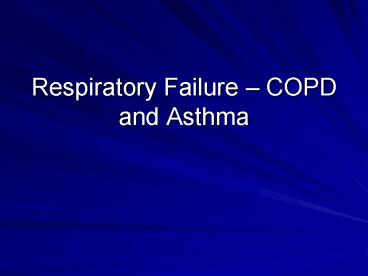Respiratory Failure - PowerPoint PPT Presentation
1 / 20
Title:
Respiratory Failure
Description:
Respiratory Failure COPD and Asthma 59 year old man presents to the ER with a 3 day history of progressively worsening shortness of breath. – PowerPoint PPT presentation
Number of Views:206
Avg rating:3.0/5.0
Title: Respiratory Failure
1
Respiratory Failure COPD and Asthma
2
- 59 year old man presents to the ER with a 3 day
history of progressively worsening shortness of
breath. - He has a past history of chronic lung disease
that started about 5 years ago and he is an
ex-smoker for about 6 months since his family
doctor threatened to put him on home oxygen.
3
- What additional information do you want on
history? - The patient states that he has had a chronic
productive cough for years and over the last week
he has noticed a changed in the amount and color
of his sputum. - Denies any recent travel, sick contacts (although
grandkids visited about 10 days ago), fevers,
chest pain, orthopnea, past hospitalizations or
surgeries. - Still works as an accountant.
4
Initial CXR
5
- On examination, his chest sounds are distant with
some wheeze and prolonged exhalation. Heart
sounds are difficult to hear. - He is unable to speak in complete sentences and
is in moderate to severe respiratory distress. - Room air ABG pH 7.19, PCO2 76, PO2 53, HCO3 35
- WBC 12.7, Bands 9, Hgb 186, Platelets 250
6
- What is the most likely diagnosis?
- What is the differential diagnosis?
- Why is the PCO2 elevated?
- What are the determinants of blood CO2
concentrations? - What is dead space ventilation and what is the
difference between anatomical and physiological
dead space? - How is dead space ventilation different from
shunt? - Why is the PO2 low?
7
- What are the factors that influence respiratory
muscle strength? - Consider
- Fatigue
- Malnutrition
- Hypoperfusion
- Myopathy
- Steroids
- Electrolyte derangements
8
- What are the factors that influence respiratory
muscle load? - Consider
- Bronchospasm
- Secretions
- Dynamic hyperinflation
- Atelectasis
- Increase CO2 production
- Infection
- Pneumothorax
- Abdominal distension
9
- What is the relationship between respiratory
muscle strength and load in acute on chronic
respiratory failure? - The patients respiratory distress has not
improved with all of this physiology talk. - What is the approach to the treatment of acute on
chronic respiratory failure in the emergency
department?
10
- After starting frequent bronchodilators, steroids
and empiric antibiotics, the patient is not
feeling better. - What is the role for non-invasive positive
pressure ventilation for this problem? - What are the indications and contraindications
for NIPPV? - How does NIPPV work in acute on chronic
respiratory failure?
11
- After applying NIPPV, the patient begins to feel
better and eventually is transferred to the ward. - If he had not improved, how would you know and
what would you do? - Bonus question What causes the PCO2 to rise on
high flow oxygen? How common is it? Which is
more harmful hypercarbia or hypoxemia?
12
Next Case
- 19 year old woman with a 12 year history of
asthma presents to the ER with 3 day history of
increasing shortness of breath and cough. - She recently rescued a cat from the pound and
started dating a boy who smokes. - She has been to the ER about one per year for
asthma attacks, admitted twice and never in ICU. - She uses ventolin about 6 times per day.
13
- On examination, she is in severe respiratory
distress with a rate of 31, pulse 124, and O2
saturations of 100 on face mask. - Her blood pressure is 151/83 with a pulsus
paradoxus of 25. - What is a pulsus paradoxus?
- If her pulsus was 15, would you be reassured?
14
- What investigations would you order?
- What treatments would you order?
- What is the role of heliox and non-invasive
positive pressure ventilation in severe asthma? - Her ABG on face mask is pH 7.20, PCO2 35, PO2
123, HCO3 17 - Is this a reassuring ABG? Why or why not?
15
CXR
16
- After 35 minutes of continuous therapy, her work
of breathing is about the same, she can speak in
short words only and is becoming difficult to
arouse. - What do you do next?
- What are the indications for intubation in severe
asthma?
17
- She is successfully intubated on the first
attempt. Immediately after her blood pressure
starts to fall and she becomes pulseless but the
monitor still shows electrical activity. - What could be causing this PEA arrest?
- Consider
- Hypovolemia
- Loss of vascular tone
- Pneumothorax
- Electrolyte disorders especially pH
- Overventilation on the Ambu Bag
18
- The RT reports that she is very stiff to bag but
after disconnecting her from the bag and waiting
30 seconds, she regains a pulse. - What is dynamic hyperinflation?
- What are the consequences of dynamic
hyperinflation?
19
- Now that she is on the ventilator and more
stable, what treatments would you use for her
asthma? - How would you ventilate her?
- Despite permissive hypercarbia, she is still
difficult to ventilate? - What other treatments are available?
20
Question??































